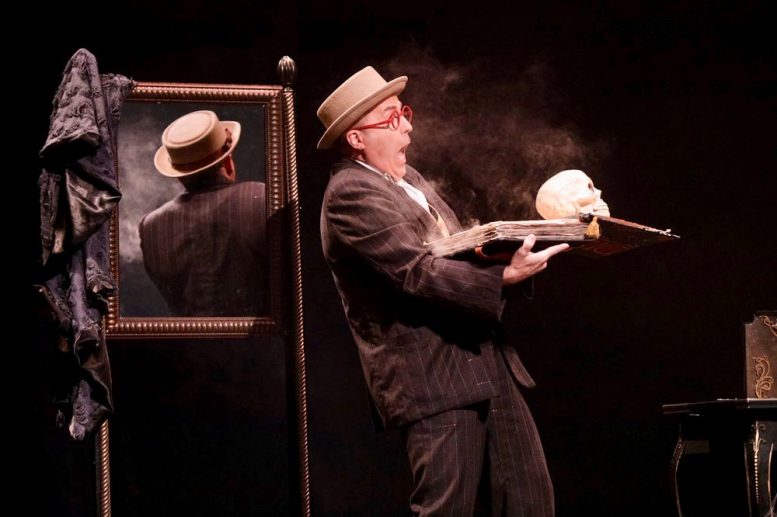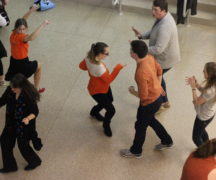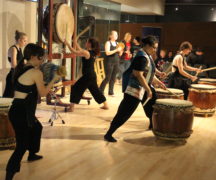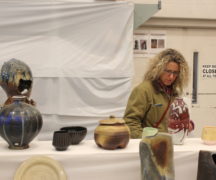By DAVID DUPONT
BG Independent News
Fooling Penn and Teller wasn’t enough for magician Stuart MacDonald.
Back in 2017 he took his Magic Castle act to their show “Fool Us.” And he won.
The act had already swept the Internationals in Magic competition. Still he wasn’t resting on his top hat.
He has continued to refine both the illusions and the story telling in Magic Castle.
Michigan-native MacDonald will be the featured performer Saturday, Dec. 7 at ArtsX at the Fine Arts Center and the Wolfe Center for the Arts on the Bowling Green State University campus. ArtsX is a celebration of art in all its forms as well as an arts fair featuring work created by students.
MacDonald will perform the 45-minute show at 5:30 and 7 p.m. during the free event, which runs from 5-9 p.m.
What he performed for Penn & Teller is “not what it is now.” The mirror is the same, but now it has cobwebs. “Everything has a creepy feel.”
There are more illusions but just as important “it’s a much better story,” he said in a recent telephone interview.
MacDonald is a storytelling magician. His illusions may be inspired by other magicians but his character is inspired by Lou Costello of the classic Abbott and Costello comedy team. “He’s an everyman,” MacDonald said. “He’s one of us.” This everyman has inherited a spooky mansion from a great-geat-great-grandfather who was a magician. The character happens upon a room in the castle and finds a magic book and mirror, and “mayhem ensues,” MacDonald said.
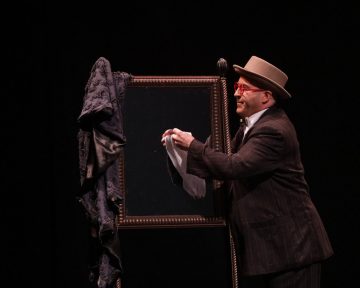
(Photo by Michael Messing/provided)
He becomes an accidental magician, and through a theatrical magic he touches viewers beyond what trickery alone would make possible.
“The whole thing is done silently,” MacDonald said. “Listening to people after the performance they all have a different take on it. That to me is the most fascinating part of this — it touches people in different ways.”
There is a common thread. “Everybody says the same thing: ‘It was like watching a movie.’”
One fan told him: “I was in that room with you. Everything went away.” Then he asked: “How do you tour with that big set?”
The fan was convinced the entire castle was a physical set. “I didn’t have a castle,” MacDonald told him. “I only have a table and mirror. He was blown away, and so was I that he was convinced I had this giant set.”
While on campus MacDonald will work with students. His message is that magic is another way to tell a story. Just look at the success of magic-centric shows on Broadway, “Harry Potter and the Cursed Child,” “Beetlejuice,” and Derren Brown’s “Secret.”
He has a former assistant now in New York, and everyone wants to know about his time working with a magician.
MacDonald has drawn on some top Broadway talent himself.
He first got the entire idea of the mirror illusions while working on tricks in his bedroom with a mirror. He put together the act and first presented it at a major convention in St. Louis. The first version was a flop, he said. And it failed in front of the most important people in the field.
The “blessing,” MacDonald said, was that “it was completely forgettable.”
He knew it had potential, and he wanted to take it to the international championships. So he reached out to Tony Ost, a Tony-winning scenic designer for “Newsies.”
Ost and MacDonald both grew up in Kalamazoo, so MacDonald hoped to get a little feedback on the show. So he sent Ost a Facebook message. Ost called him right back.
Unbeknownst to MacDonald they had a closer connection.
Ost is a few years younger than MacDonald. When he was in sixth grade, MacDonald, then in high school, called him up on stage to assist with a rope trick. This was Ost’s first theatrical experience, the first rung on the ladder to Broadway.
Now he wanted to pay back MacDonald.
They collaborated on the show. Ost’s questions prompted more renovations for the Magic Castle. MacDonald ended up placing at the championships. But improving the show goes on.
That will be part of his message to students. He will talk to them about how he develops the story line and the character, and even clue them into how some of the illusions are accomplished. Those attending the session will have to sign an agreement not to share those secrets.
“I’m telling them that people in the arts who are highly skilled in singing, dancing, acting, even figure skating, are using magic as an extra craft in their toolkit.”
Magic, he said, “is in a golden age.”
That wasn’t the case as he was learning his craft.
MacDonald, 55, got a Hocus Pocus magic kit from an uncle when he was a child. The instructions were in four different languages, and that fascinated him.
He liked magic because as a shy kid it was a way to interact with people. It wasn’t until he was in ninth grade that he started to excel.
He learned about Abbott’s Magic Company in Michigan, and about the annual convention the company hosts. He attended, went to workshops, and met other magicians. He learned there was a contest, and he dedicated himself to winning it. That took six years.
He studied theater at Adrian College. Magic and theater didn’t seem to fit together back then. People thought of magic as pulling a penny from someone’s ear, as entertainment at a kid’s birthday party.
MacDonald found he could earn a living from it. Starting in the late 1980s he and his wife, Lori, had an act that toured more than 1,000 college campuses, including BGSU, where both his parents attended. His father was a fraternity brother of comedian Tim Conway.
“Magic started as a social tool ,then it became a craft, then it became an art form, then source of income,”
That took more than illusion and waving a magic wand, though.
“I kept pursuing magic as anyone would any craft,” MacDonald said, “getting better at it a little at a time.”

